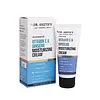What's inside
What's inside
 Key Ingredients
Key Ingredients

 Benefits
Benefits

 Concerns
Concerns

 Ingredients Side-by-side
Ingredients Side-by-side

Water
Skin ConditioningParaffinum Liquidum
EmollientTocopheryl Acetate
AntioxidantPropylene Glycol
HumectantSteareth-2
EmulsifyingCaprylic/Capric Triglyceride
MaskingCetyl Alcohol
EmollientSteareth-21
CleansingPEG-20
HumectantDimethicone
EmollientXylitylglucoside
HumectantAnhydroxylitol
HumectantXylitol
HumectantStearyl Alcohol
EmollientSodium Acrylates Copolymer
Lecithin
EmollientPhenoxyethanol
PreservativeTriethanolamine
BufferingBHT
AntioxidantPotassium Sorbate
PreservativeDisodium EDTA
Citric Acid
BufferingPanax Ginseng Root Extract
EmollientWater, Paraffinum Liquidum, Tocopheryl Acetate, Propylene Glycol, Steareth-2, Caprylic/Capric Triglyceride, Cetyl Alcohol, Steareth-21, PEG-20, Dimethicone, Xylitylglucoside, Anhydroxylitol, Xylitol, Stearyl Alcohol, Sodium Acrylates Copolymer, Lecithin, Phenoxyethanol, Triethanolamine, BHT, Potassium Sorbate, Disodium EDTA, Citric Acid, Panax Ginseng Root Extract
Water
Skin ConditioningNiacinamide
SmoothingPropanediol
SolventCentella Asiatica Extract
CleansingCaprylic/Capric Triglyceride
MaskingGlycerin
HumectantXylitol
HumectantGlucose
HumectantAnhydroxylitol
HumectantPhoenix Dactylifera Seed Extract
MoisturisingAdenosine Phosphate
Skin ConditioningC13-15 Alkane
SolventCoco-Glucoside
CleansingButyrospermum Parkii Butter
Skin ConditioningStearic Acid
CleansingHydrogenated Ethylhexyl Olivate
EmollientHydrogenated Olive Oil Unsaponifiables
EmollientHyaluronic Acid
HumectantPhenoxyethanol
PreservativeEthylhexylglycerin
Skin ConditioningPentylene Glycol
Skin ConditioningFructose
HumectantUrea
BufferingCitric Acid
BufferingMaltose
MaskingSodium PCA
HumectantSodium Chloride
MaskingSodium Lactate
BufferingTrehalose
HumectantAllantoin
Skin ConditioningCetyl Alcohol
EmollientAcrylates/C10-30 Alkyl Acrylate Crosspolymer
Emulsion StabilisingPanthenol
Skin ConditioningEthoxydiglycol
HumectantTocopherol
AntioxidantZinc PCA
HumectantCapryloyl Glycine
CleansingSarcosine
Skin ConditioningCinnamomum Zeylanicum Bark Extract
AntimicrobialSodium Hydroxide
BufferingSodium Gluconate
Skin ConditioningWater, Niacinamide, Propanediol, Centella Asiatica Extract, Caprylic/Capric Triglyceride, Glycerin, Xylitol, Glucose, Anhydroxylitol, Phoenix Dactylifera Seed Extract, Adenosine Phosphate, C13-15 Alkane, Coco-Glucoside, Butyrospermum Parkii Butter, Stearic Acid, Hydrogenated Ethylhexyl Olivate, Hydrogenated Olive Oil Unsaponifiables, Hyaluronic Acid, Phenoxyethanol, Ethylhexylglycerin, Pentylene Glycol, Fructose, Urea, Citric Acid, Maltose, Sodium PCA, Sodium Chloride, Sodium Lactate, Trehalose, Allantoin, Cetyl Alcohol, Acrylates/C10-30 Alkyl Acrylate Crosspolymer, Panthenol, Ethoxydiglycol, Tocopherol, Zinc PCA, Capryloyl Glycine, Sarcosine, Cinnamomum Zeylanicum Bark Extract, Sodium Hydroxide, Sodium Gluconate
Ingredients Explained
These ingredients are found in both products.
Ingredients higher up in an ingredient list are typically present in a larger amount.
This ingredient is created from dehydrating xylitol in acidic conditions. Xylitol is a famous sugar and humectant.
Much like its predecessor, anhydroxylitol is a humectant. Humectants attract and hold water to moisturize the skin.
This ingredient is most commonly found in a popular trio called Aquaxyl. Aquaxyl is made up of anhydroxylitol (24 - 34%), xylitylglucoside (35 - 50%), and xylitol (5 - 15%).
According to a manufacturer, Aquaxyl is known for a 3-D hydration concept and an anti-dehydration shield to reinforce the outer layer of skin.
This ingredient is often derived from plants such as wood and sugarcane.
Learn more about AnhydroxylitolThis ingredient is an emollient, solvent, and texture enhancer. It is considered a skin-softener by helping the skin prevent moisture loss.
It helps thicken a product's formula and makes it easier to spread by dissolving clumping compounds.
Caprylic Triglyceride is made by combining glycerin with coconut oil, forming a clear liquid.
While there is an assumption Caprylic Triglyceride can clog pores due to it being derived from coconut oil, there is no research supporting this.
Learn more about Caprylic/Capric TriglycerideCetyl Alcohol is a fatty alcohol. Fatty Alcohols are most often used as an emollient or to thicken a product.
Its main roles are:
Though it has "alcohol" in the name, it is not related to denatured alcohol or ethyl alcohol.
The FDA allows products labeled "alcohol-free" to have fatty alcohols.
Learn more about Cetyl AlcoholCitric Acid is an alpha hydroxy acid (AHA) naturally found in citrus fruits like oranges, lemons, and limes.
Like other AHAs, citric acid can exfoliate skin by breaking down the bonds that hold dead skin cells together. This helps reveal smoother and brighter skin underneath.
However, this exfoliating effect only happens at high concentrations (20%) which can be hard to find in cosmetic products.
Due to this, citric acid is usually included in small amounts as a pH adjuster. This helps keep products slightly more acidic and compatible with skin's natural pH.
In skincare formulas, citric acid can:
While it can provide some skin benefits, research shows lactic acid and glycolic acid are generally more effective and less irritating exfoliants.
Most citric acid used in skincare today is made by fermenting sugars (usually from molasses). This synthetic version is identical to the natural citrus form but easier to stabilize and use in formulations.
Read more about some other popular AHA's here:
Learn more about Citric AcidPhenoxyethanol is a preservative that has germicide, antimicrobial, and aromatic properties. Studies show that phenoxyethanol can prevent microbial growth. By itself, it has a scent that is similar to that of a rose.
It's often used in formulations along with Caprylyl Glycol to preserve the shelf life of products.
Water. It's the most common cosmetic ingredient of all. You'll usually see it at the top of ingredient lists, meaning that it makes up the largest part of the product.
So why is it so popular? Water most often acts as a solvent - this means that it helps dissolve other ingredients into the formulation.
You'll also recognize water as that liquid we all need to stay alive. If you see this, drink a glass of water. Stay hydrated!
Learn more about WaterXylitol is a humectant and prebiotic. It can help with dry skin.
In studies, xylitol has been shown to improve dry skin. It decreased transepidermal water loss, or when water passes through the skin and evaporates. Xylitol also showed to help improve the biomechanical properties of the skin barrier.
The prebiotic property of xylitol may also help reinforce our skin's natural microbiome. Having a healthy microbiome prevents infection by bad bacteria and helps with hydration.
As a humectant, Xylitol helps draw moisture from both the air and from deeper skin layers. This helps keep skin hydrated.
Xylitol is a sugar alcohol and commonly used as a sugar substitute. It is naturally occurring in plants such as strawberries and pumpkin.
Learn more about Xylitol